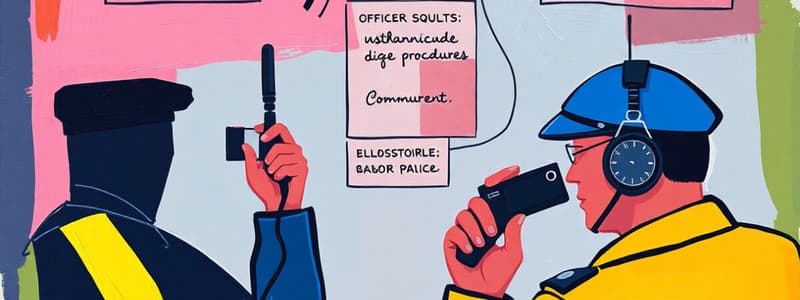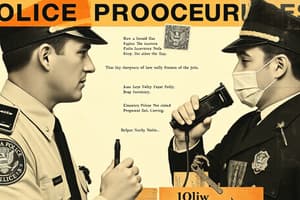Podcast
Questions and Answers
Which of the following statements is TRUE based on the content provided?
Which of the following statements is TRUE based on the content provided?
- The content provided details the specific procedures for utilizing different radio status codes, including '10-10', '8-0', and '9-5'.
- The use of status codes is mandatory only for officers on break periods.
- Officers are required to inform 911 Dispatch when they are entering their vehicle, regardless of their current status.
- The utilization of radio status codes is intended to enhance officer safety and support 911 Dispatch operations. (correct)
Based on the passage, what is the primary purpose of the policy regarding status codes?
Based on the passage, what is the primary purpose of the policy regarding status codes?
- To ensure effective communication between officers and 911 Dispatch, prioritizing officer safety and operational efficiency. (correct)
- To establish a clear chain of command for all communication between officers and 911 Dispatch.
- To provide specific instructions for officers on different radio status codes.
- To emphasize the importance of confidentiality within the Omaha Police Department.
Which of these statements regarding the content is TRUE?
Which of these statements regarding the content is TRUE?
- The content highlights the importance of confidentiality, especially when it comes to radio status codes.
- The Omaha Police Department emphasizes the importance of using appropriate status codes to enhance safety and communication. (correct)
- The Omaha Police Department has a policy regarding confidential information, but not specifically status codes.
- The policy includes detailed procedures for each relevant status code.
What can be inferred from the "REFERENCES" section of the document?
What can be inferred from the "REFERENCES" section of the document?
Which of these statements is a FALSE inference from the content provided?
Which of these statements is a FALSE inference from the content provided?
Flashcards
Confidential Policy
Confidential Policy
The OPD policy stating radio status codes are confidential for officer safety.
10-10 Status
10-10 Status
A status code used by OPD for specific operational situations.
8-0 Status
8-0 Status
A particular radio status used by OPD that indicates a specific condition or action.
9-5 Status
9-5 Status
Signup and view all the flashcards
Officer Notification
Officer Notification
Signup and view all the flashcards
Study Notes
Radio Procedures - Special Status Codes
- This policy is confidential
- Officers must use appropriate radio status codes for officer safety and 911 dispatch
- Officers must notify 911 dispatch of their status during breaks and when out of their vehicle for assignments
10-10 Status
- Officers going "10-10" (out of vehicle but available) on assignments must specify their location during the "10-10" period
- Officers entering private residences for interviews/follow-ups must document this in supplementary reports
- 911 dispatch must be informed if officers are in private residences (except for normal dispatching)
- When leaving a vehicle officers must inform their supervisor of their location and the purpose
- Uniform patrol officers are required to use "10-10" twice during their shift to conduct community policing
- Contact and build relationships with people in their district
- Discuss criminal activity in the area
- Gather suggestions for improving police services
- "10-10" assignments are at officer discretion, especially during busy periods, and can be used at areas where people congregate
- Do not use "10-10" with traffic stops
8-0 and 9-5 Statuses
- Officers assigned to patrol duties can take meal ("8-0") and restroom ("9-5") breaks while on duty
- Officers remain on duty during breaks, following OPD policies and procedures, collective bargaining agreements
- Authorized "8-0" and "9-5" locations include public restaurants, coffee shops, and OPD facilities
- Officers may be allowed to take "8-0" and "9-5" at locations outside of their sergeant's area, within their assigned precinct, with prior authorization from their supervisor
- Individuals can take "8-0" and "9-5", if their residence or a close relative's residence is within their assigned precinct, with supervisor approval
- Officers driving marked cruisers should avoid situations with more than two marked cruisers or three uniformed officers at locations like car washes at any one time
- Exceptions include sworn supervisors with up to three uniformed officers and situations approved by a supervisor
- Supervisors can't allow "8-0" if less than 2 marked cruisers or 2 uniformed patrol officers are present at the time
- Supervisors can allow the use of "8-0" or "9-5" based on call load and staffing levels
- "8-0" time limit is 40 minutes, and "9-5" time limit is 10 minutes per shift (2 per shift)
- Officers need to advise 911 dispatch of "8-0" and "9-5" locations
- Officers need to provide 911 dispatch with their "10-7" time (start of break), "10-8" time (end of break) and location during breaks
Studying That Suits You
Use AI to generate personalized quizzes and flashcards to suit your learning preferences.





